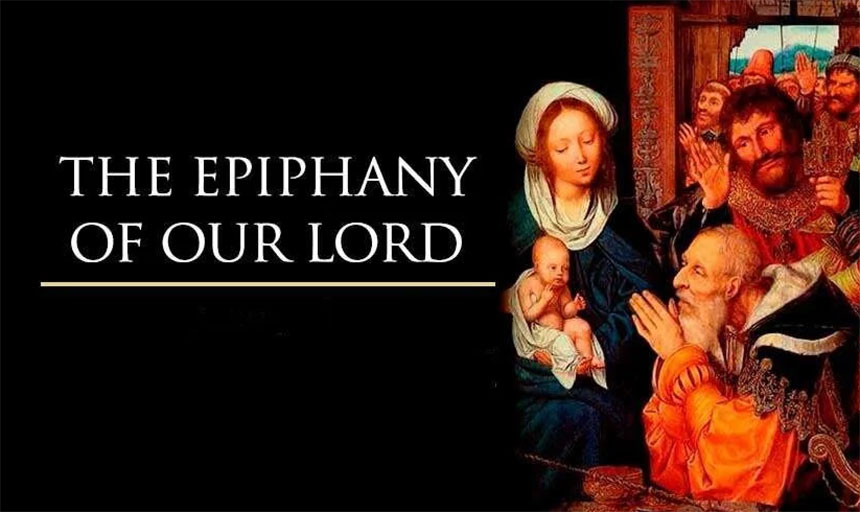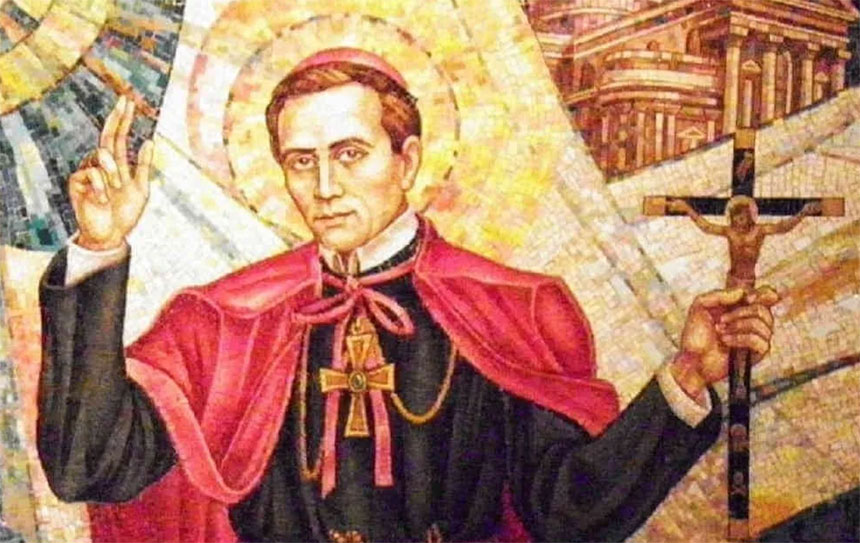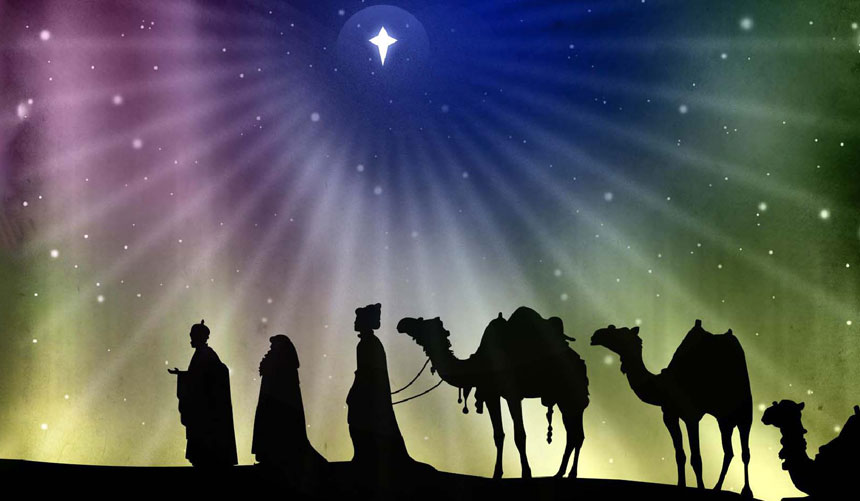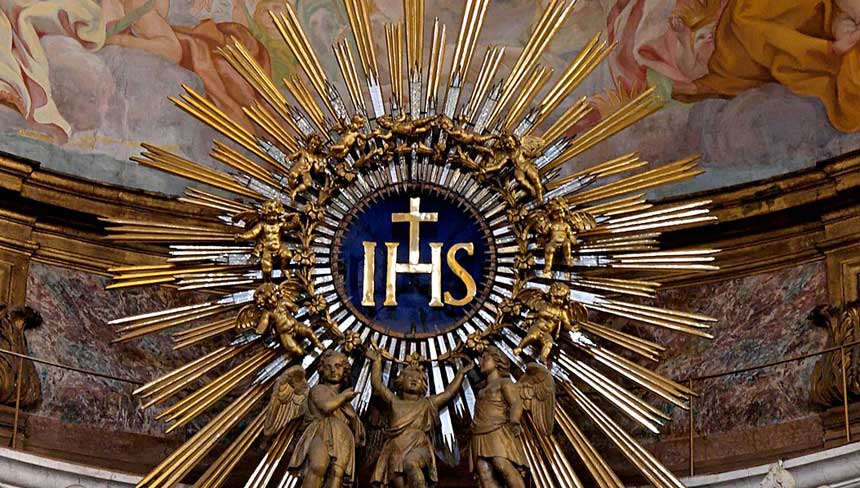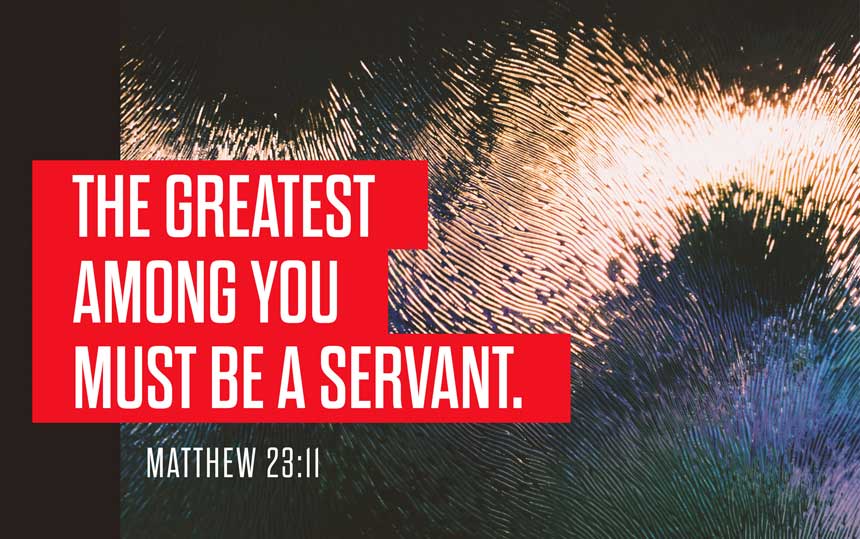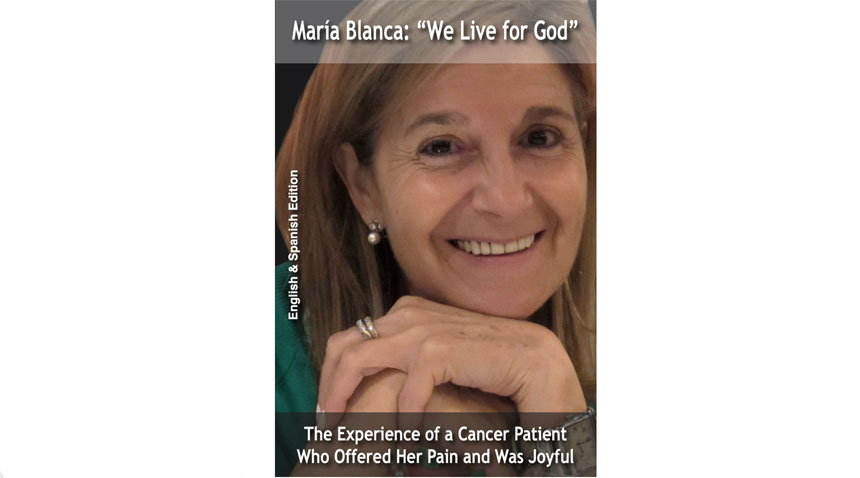“Good evening, everyone. On behalf of Fr. La Pastina, the pastor of this church, welcome to all of you to the Basilica of St. John the Evangelist. Welcome to this Memorial Mass for María Blanca González de Amigot, and thank you very much for your presence here this evening. My name is Fr. David Rider, and I’d like to thank Mikel and his family for giving me the honor of celebrating and preaching at this Mass tonight.
Today is exactly three years since María Blanca departed this world for eternal life. At 4:21am, on October 28, 2021, María Blanca took her last breath on this earth. Mikel, Miguel, Jaione, even though three years have passed, I’m sure the grief at the loss of such a wonderful wife and mother is still alive in your hearts. Today, all of us gathered here for this Mass join the three of you, along with Blanca – who joins us in spirit – in thanking God for the holy wife and mother he blessed you with. María Blanca had a very precise understanding of her mission in life: to save her own soul and to get the four of you to heaven. Everything she did in her life on earth was aimed at fulfilling this mission. Three years ago today, she completed the first part of that mission when she died in the state of grace. Now, from heaven, she continues to fulfill the second part of that mission through her intercession for you before God, and she will continue to fulfill it until she sees each of you cross the finish line of your own lives and join her one day in the kingdom of heaven. May you remain forever grateful for the incredible blessing of a wife and mother who cared, more than anything else, about your spiritual and eternal welfare.
When St. Clare of Assisi was canonized in 1255 – only two years after her death – the Pope who canonized her said that she had left a trail of light behind her when she passed away. The Pope at the time said of St. Clare, “How powerful was the illumination of this light and how strong the brightness of this source of light” (Pope Alexander IV, Clara Claris Praeclara). Today we can surely say the same about María Blanca: she left a trail of light behind her when she died, a trail of light which burns brightly even three years after her death. How powerful was the illumination of the light of María Blanca, and how strong the brightness of this source of light!
When María Blanca went home to God, she passed the torch that produced this light to her husband and children, and through them, to all of us who would come to know of her. The light of that torch is meant to be kept burning brightly, not only by keeping the memory of María Blanca alive, but by living our own lives differently for having known her or even simply for having come to know her story. Could I suggest three ways this evening that we can keep María Blanca’s light burning brightly, three lessons that we can learn from her life so that the light of Jesus that radiated from her can also radiate from us?
The first thing we can learn from María Blanca is love for the Eucharist. María Blanca had a deep love for the Most Holy Eucharist, which our faith tells us is the Body and Blood of the man who called himself the Light of the World. In her final illness, the high point of her every day in the hospital was when the hospital chaplains would bring her Holy Communion. María Blanca had such reverence for the Blessed Sacrament, that she would never speak to the priests who brought her Communion. She loved priests, but she loved Jesus even more, and out of respect for Him she would always receive the Eucharist in silence and enter into deep prayer immediately after consuming it. During her personal way of the cross at the Burns Intensive Care Unit, the Eucharist was her main source of strength, and she could not go a day without receiving it. When the doctors encouraged her to quarantine in the summer of 2021 for fear that she would contract a virus, a family friend, Fr. Germán Martínez told her that she was dispensed from the obligation to attend Sunday Mass. But María Blanca replied, “No way, Father Germán, I cannot live without the Eucharist” (María Blanca: ‘We Live for God’, 22). And so, with a double mask and every precaution possible, María Blanca continued going to Mass and receiving Communion. And this love for the Eucharist was not something that only began when she got sick, either. Even before she ever got her diagnosis, she went to daily Mass. During COVID, when Masses were canceled, she took advantage of every opportunity possible to leave the house for Eucharistic Adoration. In the Gospel we just heard Jesus said, “Whoever eats my flesh and drinks my blood has eternal life and I will raise him on the last day” (Jn 6:54). If tonight we express our belief that María Blanca is in heaven, one reason we can say so with confidence is because during her life on earth she received the Body and Blood of Our Lord Jesus Christ so many times with devotion. We who remain on earth can learn so much from her deep love for Jesus in the Blessed Sacrament.
A second lesson we can learn from María Blanca – a lesson not always easy to put into practice – is not to complain. In her notes from a retreat she made in February of 2018 we find the following resolution: “Don’t complain. Embrace the cross, embrace Golgotha.” By the grace of God, María Blanca fulfilled that resolution when it came time for her own ascent of Golgotha. One of the most frequent observations made about María Blanca during her illness was that she never complained. This was a woman who experienced a pain so intense that not even Fentanyl gave her relief. Her body was covered with sores and forty percent of it was burned. She had to lie in the same position in bed for days on end. And yet, not one complaint ever issued from her mouth. The doctors and nurses who treated her marveled that they had never met a patient with an attitude as positive as hers. When people would call to see how she was doing, instead of reciting her litany of sorrows she would quickly turn the conversation around and make it about the other. Even when people tried to induce her to complain, she would simply say, “Jesus, poor thing, suffered more than anyone” (María Blanca: ‘We Live for God’, 19). A very wise man once said that if you could do only one thing to become a saint, the single most powerful thing you could do would be to give up complaining. How much progress we could make in holiness simply by not complaining, and yet, how often do we complain about crosses far, far smaller than the one María Blanca carried? María Blanca teaches us by her beautiful example to embrace God’s will with a smile, even when that means embracing the cross.
And a final lesson that María Blanca teaches us is the importance of prayer and sacrifice for the conversion of sinners. Beside her bed in the hospital was a statue of Our Lady of Fatima, and around her wrist she wore a rosary bracelet that she had bought in Fatima. María Blanca was well aware of Our Lady of Fatima’s plea for prayer and sacrifice for the conversion of sinners. When Our Lady first appeared to the three shepherd children on May 13, 1917, she asked them, “Are you willing to offer yourselves to God, to endure all the sufferings he may please to send you as an act of reparation for the sins by which he is offended and to ask for the conversion of sinners?” The oldest of the three children, Lucia, speaking for all three, said, “Yes.” And Our Lady said back, “Then you will have much to suffer, but the grace of God will be your comfort.” María Blanca heard this same call in the depth of her heart, and she too, said yes to it. One of María Blanca’s favorite books was the Diary of Divine Mercy, by St. Faustina Kowalska. In one of the many apparitions St. Faustina had of Jesus, Jesus told her that the prayer most pleasing to him was prayer for the conversion of sinners. Jesus said, “The loss of each soul plunges Me into mortal sadness. You always console Me when you pray for sinners. The prayer most pleasing to Me is prayer for the conversion of sinners. Know, My daughter, that this prayer is always heard and answered” (§1397). María Blanca had a great desire to console the heart of Jesus, and she did that by her prayers and sacrifices for the conversion of sinners. She had truly internalized these messages of Jesus and Mary, and she responded to them with great generosity. She offered up to God the Father, in union with Jesus, all of the excruciating pain she went through for the conversion of sinners. It was for this intention that she offered up all the sores, all the burns, all the chemo, all the humiliations, and the loss of her hair. One of the main reasons why she never complained was that she didn’t want to lose any of the graces that she could be winning for sinners. Shortly before she died she left her family a voice memo saying that, despite everything she had gone through, she was happy because she had lived for God and offered all her suffering for the conversion of souls. María Blanca truly lived her life in light of eternity. She understood that nothing else matters in life if we don’t make it to heaven, and she knew that the opposite of heaven is a real possibility for every person, as Jesus himself says so often in the Gospels. She also knew that suffering joined to love is the most powerful force in the world, and so, she joined her suffering to love for poor sinners. We will only see in heaven how many souls made it there thanks to María Blanca’s prayers and sacrifices. In a time when praying and sacrificing for the conversion of sinners sounds old-fashioned and obsolete, María Blanca reminds us of the absolute urgency of responding to this appeal from heaven, which Jesus and Mary have repeated so many times during their apparitions on earth in the last century.
Pope St. John Paul II wrote fourteen encyclicals during his twenty-six years as Pope. It has often been said that his fifteenth encyclical was his example of Christian suffering during his final battle with Parkinson’s’ Disease. He taught us so much by the way he suffered. Well, María Blanca also taught us so much by the way she suffered, and three of the most important lessons she taught us during that time of grace were love for the Eucharist, the evil of complaining, and the importance of prayer and sacrifice for the conversion of sinners. Her example is an invitation to us to live out these lessons in our lives. If we do, then María Blanca will continue to influence the world for good, not just by her prayers from heaven, and not just through the memory of her deeds, but through each one of us. By our concrete choices to follow her example we can keep the trail of light that she left behind her moving forward in this world.
Tonight we thank God for the grace of having had our loves touched by so beautiful a soul as María Blanca González de Amigot. We thank God for her love, for her sanctity, and for her deep and profound Catholic faith. And we ask God the Holy Spirit to continue to comfort and console all of those who still feel the sting of loss left by her parting. Let us now give María Blanca last word. Three days before she died, she said these words, which she would surely repeat to all of us today if she could: “Be encouraged and hopeful. Don’t be saddened at all. God is above all. He is going to take care of you. He knows what He has to do. We live for God” (María Blanca: ‘We Live for God,’ 27).”
Fr. David Rider, Priest
• Complete Mass Video | Announcement


